Contemporary Indigenous Australian Health: Challenges and Solutions
VerifiedAdded on 2020/05/08
|5
|1012
|106
Report
AI Summary
This report provides an overview of the health challenges faced by contemporary Indigenous Australians, focusing on disparities compared to non-Indigenous populations. It highlights the complex nature of these issues, attributing them to a combination of factors including education, income, socio-economic status, and employment. The report emphasizes the role of social determinants of health and the impact of limited access to culturally appropriate and affordable health services, especially in remote areas. It discusses the need for improved healthcare accessibility, culturally sensitive health promotion campaigns, and increased funding for health services. The report also references government policies aimed at closing the gap in health outcomes, while acknowledging the historical context and the importance of social justice and human rights principles in addressing these challenges. The study uses relevant literature to support the findings and recommendations.
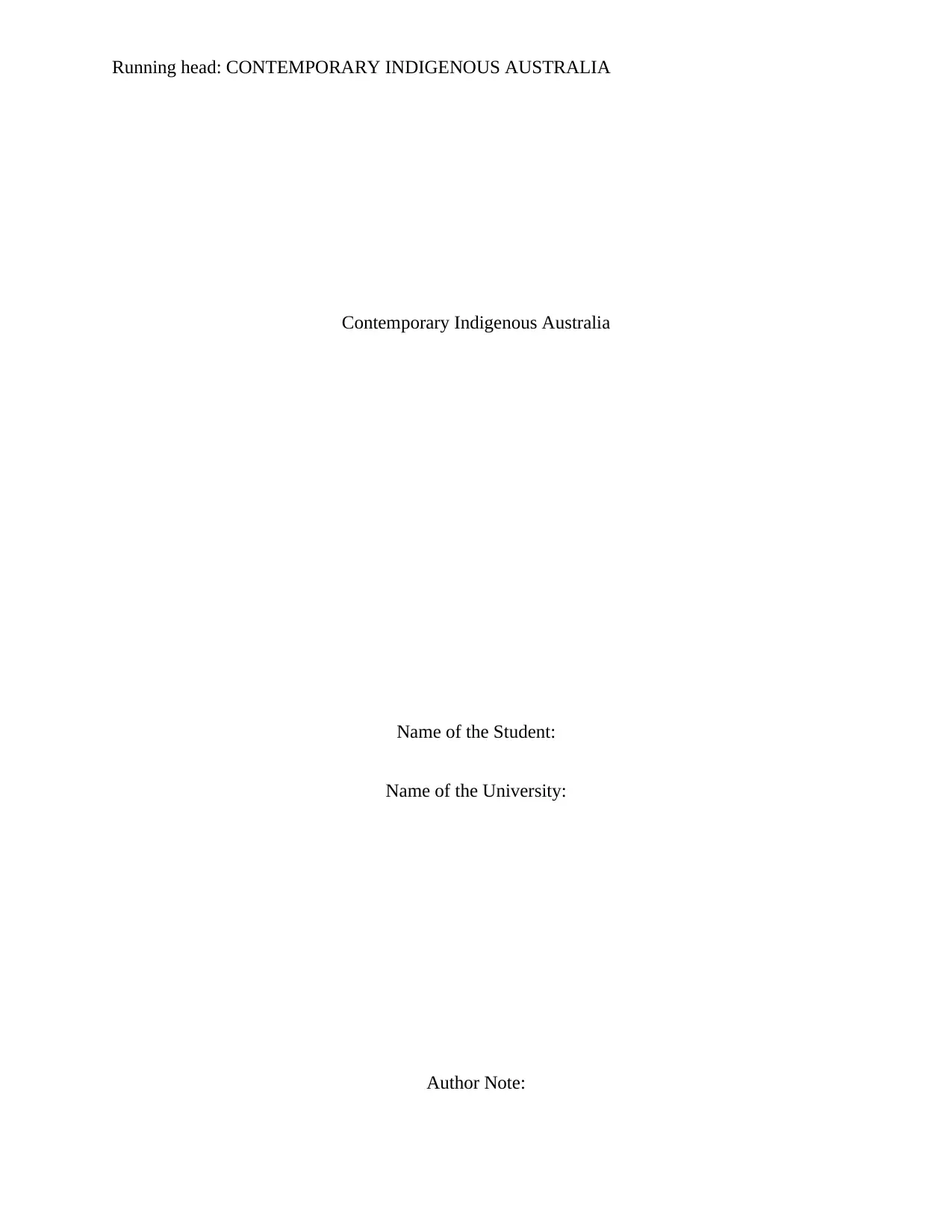
Running head: CONTEMPORARY INDIGENOUS AUSTRALIA
Contemporary Indigenous Australia
Name of the Student:
Name of the University:
Author Note:
Contemporary Indigenous Australia
Name of the Student:
Name of the University:
Author Note:
Paraphrase This Document
Need a fresh take? Get an instant paraphrase of this document with our AI Paraphraser
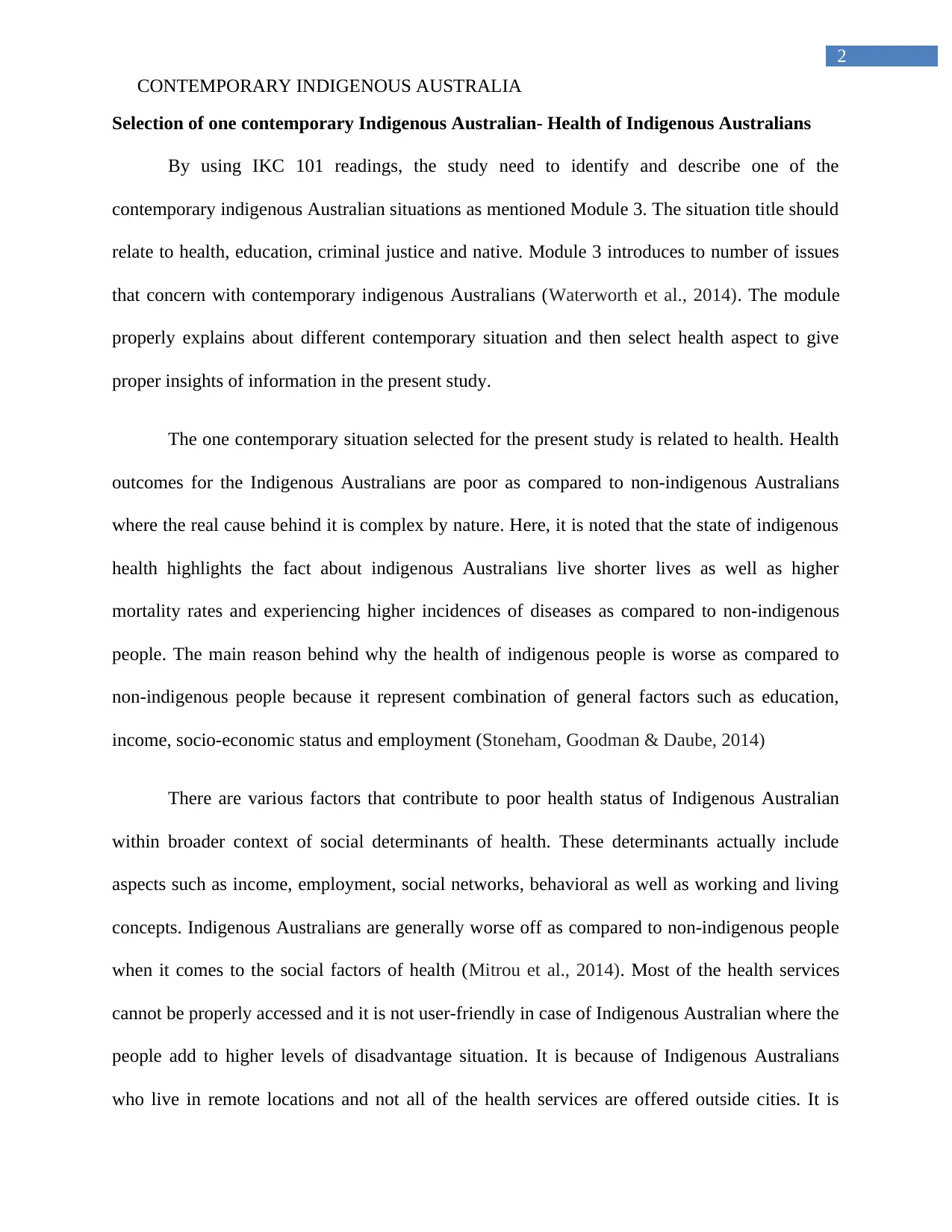
2
CONTEMPORARY INDIGENOUS AUSTRALIA
Selection of one contemporary Indigenous Australian- Health of Indigenous Australians
By using IKC 101 readings, the study need to identify and describe one of the
contemporary indigenous Australian situations as mentioned Module 3. The situation title should
relate to health, education, criminal justice and native. Module 3 introduces to number of issues
that concern with contemporary indigenous Australians (Waterworth et al., 2014). The module
properly explains about different contemporary situation and then select health aspect to give
proper insights of information in the present study.
The one contemporary situation selected for the present study is related to health. Health
outcomes for the Indigenous Australians are poor as compared to non-indigenous Australians
where the real cause behind it is complex by nature. Here, it is noted that the state of indigenous
health highlights the fact about indigenous Australians live shorter lives as well as higher
mortality rates and experiencing higher incidences of diseases as compared to non-indigenous
people. The main reason behind why the health of indigenous people is worse as compared to
non-indigenous people because it represent combination of general factors such as education,
income, socio-economic status and employment (Stoneham, Goodman & Daube, 2014)
There are various factors that contribute to poor health status of Indigenous Australian
within broader context of social determinants of health. These determinants actually include
aspects such as income, employment, social networks, behavioral as well as working and living
concepts. Indigenous Australians are generally worse off as compared to non-indigenous people
when it comes to the social factors of health (Mitrou et al., 2014). Most of the health services
cannot be properly accessed and it is not user-friendly in case of Indigenous Australian where the
people add to higher levels of disadvantage situation. It is because of Indigenous Australians
who live in remote locations and not all of the health services are offered outside cities. It is
CONTEMPORARY INDIGENOUS AUSTRALIA
Selection of one contemporary Indigenous Australian- Health of Indigenous Australians
By using IKC 101 readings, the study need to identify and describe one of the
contemporary indigenous Australian situations as mentioned Module 3. The situation title should
relate to health, education, criminal justice and native. Module 3 introduces to number of issues
that concern with contemporary indigenous Australians (Waterworth et al., 2014). The module
properly explains about different contemporary situation and then select health aspect to give
proper insights of information in the present study.
The one contemporary situation selected for the present study is related to health. Health
outcomes for the Indigenous Australians are poor as compared to non-indigenous Australians
where the real cause behind it is complex by nature. Here, it is noted that the state of indigenous
health highlights the fact about indigenous Australians live shorter lives as well as higher
mortality rates and experiencing higher incidences of diseases as compared to non-indigenous
people. The main reason behind why the health of indigenous people is worse as compared to
non-indigenous people because it represent combination of general factors such as education,
income, socio-economic status and employment (Stoneham, Goodman & Daube, 2014)
There are various factors that contribute to poor health status of Indigenous Australian
within broader context of social determinants of health. These determinants actually include
aspects such as income, employment, social networks, behavioral as well as working and living
concepts. Indigenous Australians are generally worse off as compared to non-indigenous people
when it comes to the social factors of health (Mitrou et al., 2014). Most of the health services
cannot be properly accessed and it is not user-friendly in case of Indigenous Australian where the
people add to higher levels of disadvantage situation. It is because of Indigenous Australians
who live in remote locations and not all of the health services are offered outside cities. It is
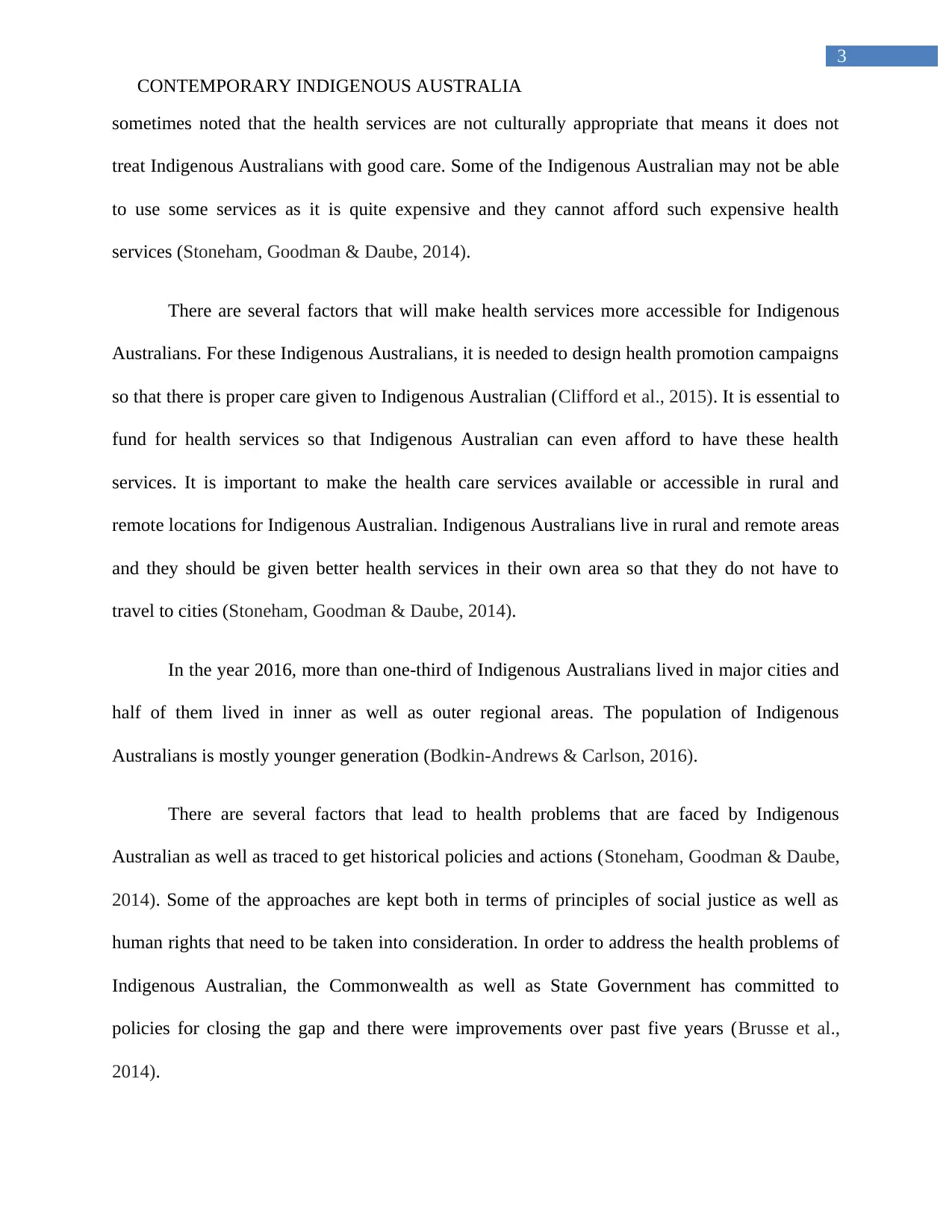
3
CONTEMPORARY INDIGENOUS AUSTRALIA
sometimes noted that the health services are not culturally appropriate that means it does not
treat Indigenous Australians with good care. Some of the Indigenous Australian may not be able
to use some services as it is quite expensive and they cannot afford such expensive health
services (Stoneham, Goodman & Daube, 2014).
There are several factors that will make health services more accessible for Indigenous
Australians. For these Indigenous Australians, it is needed to design health promotion campaigns
so that there is proper care given to Indigenous Australian (Clifford et al., 2015). It is essential to
fund for health services so that Indigenous Australian can even afford to have these health
services. It is important to make the health care services available or accessible in rural and
remote locations for Indigenous Australian. Indigenous Australians live in rural and remote areas
and they should be given better health services in their own area so that they do not have to
travel to cities (Stoneham, Goodman & Daube, 2014).
In the year 2016, more than one-third of Indigenous Australians lived in major cities and
half of them lived in inner as well as outer regional areas. The population of Indigenous
Australians is mostly younger generation (Bodkin-Andrews & Carlson, 2016).
There are several factors that lead to health problems that are faced by Indigenous
Australian as well as traced to get historical policies and actions (Stoneham, Goodman & Daube,
2014). Some of the approaches are kept both in terms of principles of social justice as well as
human rights that need to be taken into consideration. In order to address the health problems of
Indigenous Australian, the Commonwealth as well as State Government has committed to
policies for closing the gap and there were improvements over past five years (Brusse et al.,
2014).
CONTEMPORARY INDIGENOUS AUSTRALIA
sometimes noted that the health services are not culturally appropriate that means it does not
treat Indigenous Australians with good care. Some of the Indigenous Australian may not be able
to use some services as it is quite expensive and they cannot afford such expensive health
services (Stoneham, Goodman & Daube, 2014).
There are several factors that will make health services more accessible for Indigenous
Australians. For these Indigenous Australians, it is needed to design health promotion campaigns
so that there is proper care given to Indigenous Australian (Clifford et al., 2015). It is essential to
fund for health services so that Indigenous Australian can even afford to have these health
services. It is important to make the health care services available or accessible in rural and
remote locations for Indigenous Australian. Indigenous Australians live in rural and remote areas
and they should be given better health services in their own area so that they do not have to
travel to cities (Stoneham, Goodman & Daube, 2014).
In the year 2016, more than one-third of Indigenous Australians lived in major cities and
half of them lived in inner as well as outer regional areas. The population of Indigenous
Australians is mostly younger generation (Bodkin-Andrews & Carlson, 2016).
There are several factors that lead to health problems that are faced by Indigenous
Australian as well as traced to get historical policies and actions (Stoneham, Goodman & Daube,
2014). Some of the approaches are kept both in terms of principles of social justice as well as
human rights that need to be taken into consideration. In order to address the health problems of
Indigenous Australian, the Commonwealth as well as State Government has committed to
policies for closing the gap and there were improvements over past five years (Brusse et al.,
2014).
⊘ This is a preview!⊘
Do you want full access?
Subscribe today to unlock all pages.

Trusted by 1+ million students worldwide
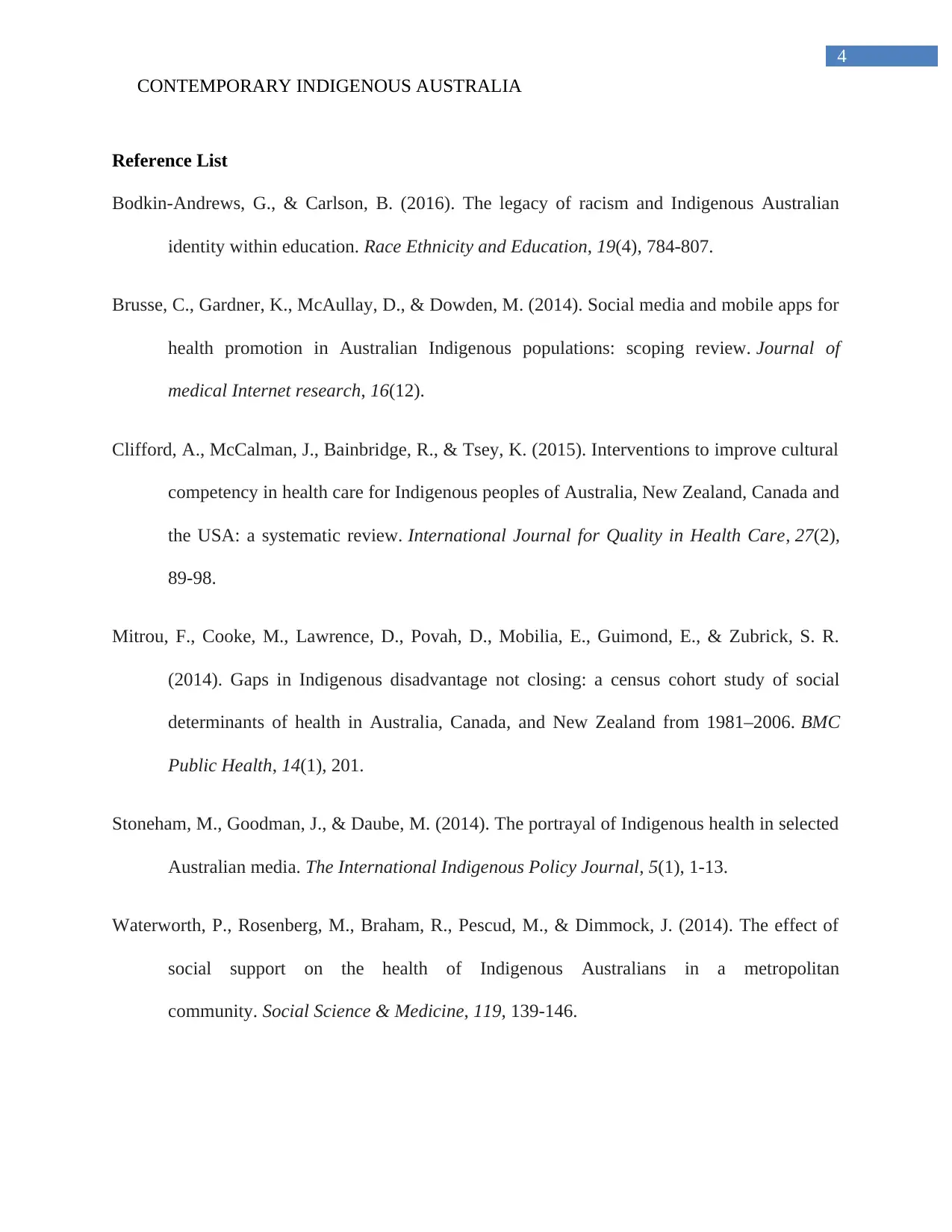
4
CONTEMPORARY INDIGENOUS AUSTRALIA
Reference List
Bodkin-Andrews, G., & Carlson, B. (2016). The legacy of racism and Indigenous Australian
identity within education. Race Ethnicity and Education, 19(4), 784-807.
Brusse, C., Gardner, K., McAullay, D., & Dowden, M. (2014). Social media and mobile apps for
health promotion in Australian Indigenous populations: scoping review. Journal of
medical Internet research, 16(12).
Clifford, A., McCalman, J., Bainbridge, R., & Tsey, K. (2015). Interventions to improve cultural
competency in health care for Indigenous peoples of Australia, New Zealand, Canada and
the USA: a systematic review. International Journal for Quality in Health Care, 27(2),
89-98.
Mitrou, F., Cooke, M., Lawrence, D., Povah, D., Mobilia, E., Guimond, E., & Zubrick, S. R.
(2014). Gaps in Indigenous disadvantage not closing: a census cohort study of social
determinants of health in Australia, Canada, and New Zealand from 1981–2006. BMC
Public Health, 14(1), 201.
Stoneham, M., Goodman, J., & Daube, M. (2014). The portrayal of Indigenous health in selected
Australian media. The International Indigenous Policy Journal, 5(1), 1-13.
Waterworth, P., Rosenberg, M., Braham, R., Pescud, M., & Dimmock, J. (2014). The effect of
social support on the health of Indigenous Australians in a metropolitan
community. Social Science & Medicine, 119, 139-146.
CONTEMPORARY INDIGENOUS AUSTRALIA
Reference List
Bodkin-Andrews, G., & Carlson, B. (2016). The legacy of racism and Indigenous Australian
identity within education. Race Ethnicity and Education, 19(4), 784-807.
Brusse, C., Gardner, K., McAullay, D., & Dowden, M. (2014). Social media and mobile apps for
health promotion in Australian Indigenous populations: scoping review. Journal of
medical Internet research, 16(12).
Clifford, A., McCalman, J., Bainbridge, R., & Tsey, K. (2015). Interventions to improve cultural
competency in health care for Indigenous peoples of Australia, New Zealand, Canada and
the USA: a systematic review. International Journal for Quality in Health Care, 27(2),
89-98.
Mitrou, F., Cooke, M., Lawrence, D., Povah, D., Mobilia, E., Guimond, E., & Zubrick, S. R.
(2014). Gaps in Indigenous disadvantage not closing: a census cohort study of social
determinants of health in Australia, Canada, and New Zealand from 1981–2006. BMC
Public Health, 14(1), 201.
Stoneham, M., Goodman, J., & Daube, M. (2014). The portrayal of Indigenous health in selected
Australian media. The International Indigenous Policy Journal, 5(1), 1-13.
Waterworth, P., Rosenberg, M., Braham, R., Pescud, M., & Dimmock, J. (2014). The effect of
social support on the health of Indigenous Australians in a metropolitan
community. Social Science & Medicine, 119, 139-146.
Paraphrase This Document
Need a fresh take? Get an instant paraphrase of this document with our AI Paraphraser
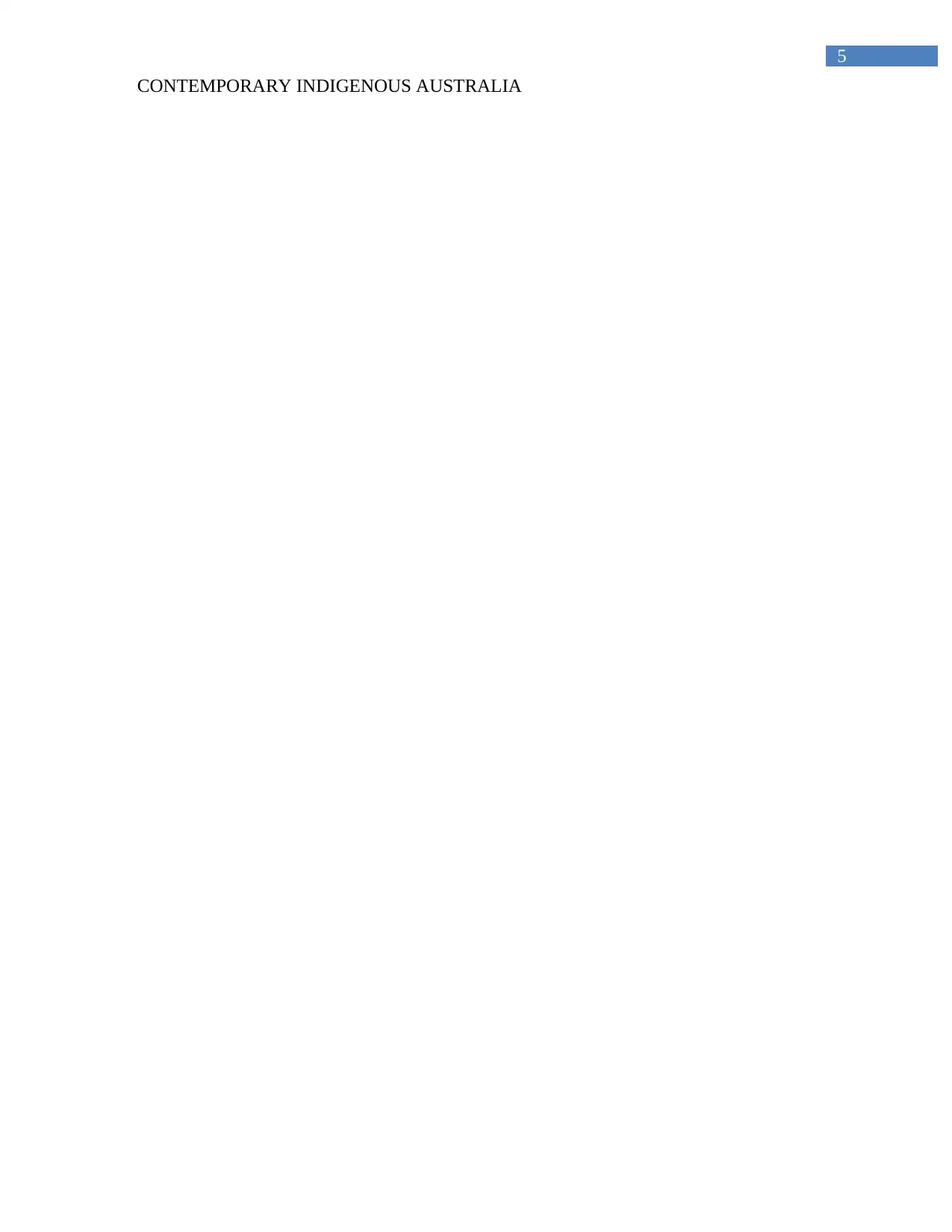
5
CONTEMPORARY INDIGENOUS AUSTRALIA
CONTEMPORARY INDIGENOUS AUSTRALIA
1 out of 5
Related Documents
Your All-in-One AI-Powered Toolkit for Academic Success.
+13062052269
info@desklib.com
Available 24*7 on WhatsApp / Email
![[object Object]](/_next/static/media/star-bottom.7253800d.svg)
Unlock your academic potential
Copyright © 2020–2025 A2Z Services. All Rights Reserved. Developed and managed by ZUCOL.




